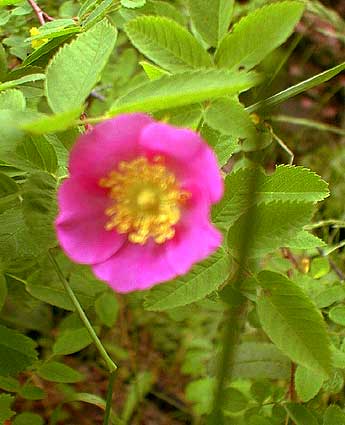
Swamp Rose
aka, Clustered Rose
or, Pea-fruit Rose
"Red Rose, proud Rose, sad Rose of all my days!
Come near me, while I sing the ancient ways."
-William Butler Yeats
(1865-1939)
The wild Swamp Rose, Clustered Rose or Pea-fruit Rose (Rosa pisocarpa), native to right here in the Pacific Northwest, has good potential for a garden ornamental, though it also has drawbacks.(1865-1939)
Even in winter its deciduous limbs have a refined upright & outward appearance, keeping many of its tiny pea-sized rose-hips through much of winter, having through autumn hung in clusters all over the limbs.
Feathery glaucus foliage of spring through autumn has a delicate beauty. May through early summer's scented pink flowers are joyous to behold. It suffers none of the diseases of domestic roses.
Being a wild species rather than tamed cultivar, it colonizes like a son of a gun, & might in consequence be preferred in a large pot that it's welcome to fill up with suckers. In the open garden it can send underground runners several feet in all directions to pop up anywhere.
In this colonizing behavior its no different than other wild roses including the much-gardened rugosa rose, which likewise spreads willynilly if suckers are not consistently removed. When small swamp roses pop up where not wanted, they're easily removed, & if potted up for some careful attention until well rooted separate from the parent.
Ultra-hardy in zones 7-8, it might be less so outside its native range, which includes coastal British Columbia, western Washington, Oregon, & northern California.
In the wild it self-selects moist locations in full sun, including alongside run-off ditches. It is most often spotted in growing in marshy ground that is only entirely dry late in summer. Its very extensive root system permits it to be surprisingly drought tolerant considering its love of swamps, & it does also grow in non-wetlands. So in the garden it does fine with average water. But if one does have a spot that floods seasonally or drains poorly so that most shrubs would be at risk of root-rot, the Swamp or Cluster Rose is just the thing for that spot.
In general its water needs can be regarded as moderate rather than high. Although it easily survives droughty conditions, it only blooms really well when in consistently moist, acidic soil. Likewise it grows well in considerable shade, but won't bloom well unless it is in bright sun. So one of its gardening drawbacks might be that it demands the best-irrigated sunniest spot to do its best, but will never be extremely showy for such prime placement.
In the wild it can be ten feet tall with six wide. But when gardened it tends to be in the three to five foot range of height & half as wide, keeping a sturdily upright habit. The longest branches occasionally weight themselves down like a weeping shrub, correctable if not liked by occasional trims. It can be kept as small as one likes with more regular pruning, & can look extremely nice trained as a loosely fountaining shrub. It doesn't require hard pruning as do domestic roses, but will bounce back swiftly if given one.
When we obtained ours it was nearly thornless & what thorns it did have were rather soft. As the main plant aged the thorns became harder but never numerous or injurious to work around, though in the wild a mature Cluster Rose can be quite viciously spiky. This seems to vary a great deal from one population to another.
It flowers anywhere from late May to July, earliest where it gets the best sun. The small pink flowers occur either singly or in clusters up to six.
Hips are initially green hence the species name pisocarpa means pea-fruit. As it ripens it turns mahogony red, darker than the hips on other Northwest native roses. It hybridizes freely with the native Nootka rose (R. nutkana), so there are intermediate forms difficult to tell apart, though in general the Nootka blooms earlier & has paler hips.
The hips can be harvested from the garden, as from the wild, in order to make jelly rich in vitamin C. Seeds must first be sieved out of the cooked pulp. The seeds should be saved, dried, ground into a powder, & added to flour for baking, being rich in Vitamin E. A tea can be made from the hips and/or young shoots, & young shoots can be pealed & eaten like asparagus.
It has been used as a medicinal plant, though efficacy is doubtful. Its roots were traditionally used to make a medicine for venereal disease, while a tonic made from the twigs & bark was believed to be useful for sundry "women's complaints" & as tonic taken after childbirth.